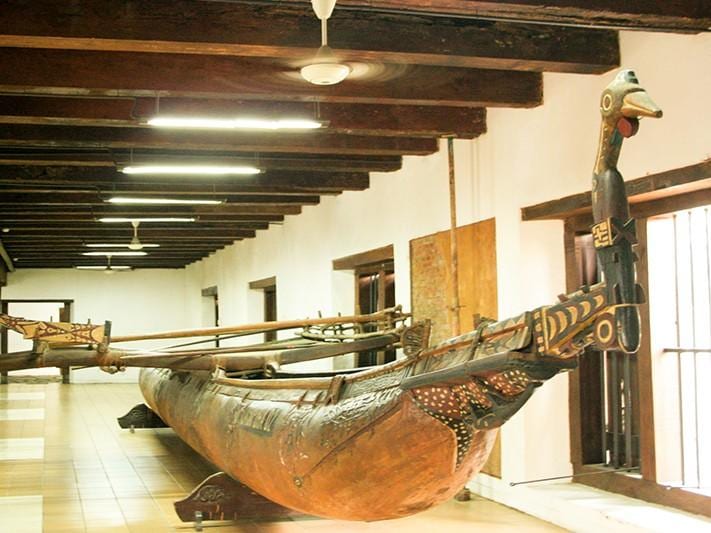On 27 February 2017, Coordinating Minister for Maritime Affairs, Luhut Pandjaitan and British Ambassador Moazzam Malik officially Opened the amazing Exhibition on the decisive World War II Battles in the Java Sea and the Sunda Straits, that are to be displayed for one whole year at the Museum Bahari otherwise known as the Jakarta Maritime Museum.

This exhibition brings to life those grim historic days in 1942 given in facts and historical traces of two of the biggest and decisive naval battles in World War II. More than 2,300 sailors and airmen were lost during these battles, 200 of whom were Indonesians serving on Dutch warships“, elaborated Ambassador Malik These events are illustrated here in the battle scenes complete with vessels used at the time.
This grand Exhibition is a collaboration between the Maritime Museum and the Embassies of the four Allied Nations involved in the battles – the United States, the United Kingdom, the Netherlands and Australia. “ It is truly an honor for the Maritime Museum to house such a great exhibition that elaborates the spirit, the history and heritage of Maritime traditions “, said Jakarta’s Maritime Museum Chief Husnison Nizar at the Opening ceremony. Preparations for the overall exhibition was supported by The Australian National Maritime Museum, the US Naval History and Heritage Command, the Dutch National Maritime Museum, Britain's National Museum of the Royal Navy and Tokyo Keizai University.
The Java Sea and Sunda Strait Battles

The decisive Java Sea Battle took place in February 1942, when the four Allied Nations joined forces deploying 2 heavy cruiser ships, 3 light cruiser ship and 9 destroyers. They collaborated in the fight against the Japanese Imperial Army despite the far bigger fleet of the Japanese comprising 2 heavy cruisers, 2 light cruisers, 14 destroyer vessels and 10 transporters. The battle cost many lives, including the Allied Commander in Chief Admiral Karel Doorman, who drowned with his sinking ship the HN LMS De Ruyter.
Whereas, the Sunda Strait Battle commenced just a few hours on the night of February 28th through March 1st 1942, involving the great battle ship of HMAS Perth from Australia and the USS Houston of the United States of America. Both bravely faced the staggeringly superior number of Japanese fleet, who fought with 20 battle ships and transport vessels. The Allied’s two ships were destroyed and sank to the sea bed along with 5 Japanese vessels. Around 1,071 Allied sailors became war casualties and 675 were taken hostage. The Japanese plans to rule over the Dutch Indies became a reality when they won both of the two historic naval battles, thus ending the reign of the Dutch in the archipelago and the beginning Japanese occupation over the Indonesian islands.
If you are excited to see more extensive details of these historic two battles, then be sure to come and explore this event. The Maritime Museum is easily reached from Kota Tua Jakarta (Old Batavia) district, and you will find the waterfront surroundings also very attractive at sunset where wooden phinisi ships lie at anchor.
The Museum Bahari or Maritime Museum

Located in Jakarta’s Kota Tua area of Old Batavia, Museum Bahari or the Maritime Museum is located at Pasar Ikan 1, North Jakarta also known as the Sunda Kelapa Harbor area. These buildings initially served as warehouses to store precious spices and other goods ready for shipment to far away Europe.
The Dutch East India Company or VOC started their construction between 1652-1774. In 1976 the warehouses were converted into a Museum which was officially inaugurated by then Governor of Jakarta, Ali Sadikin, in 1977.
Because Indonesia comprises 60% of seas, the main objective of the museum, therefore, is to maintain, protect and display Indonesia’s maritime history and the importance of the sea in the nation’s life, politics and economy. A wonderful collection of traditional Indonesian boats such as the Pinisi, Pandekawang, Alut Pasa boat from Kalimantan, a warship vessel from Maluku called Kora-Kora and a few other fishing boats used by sea traders are kept well displayed. Each one has a distinct set of high standard maritime equipment and decorative trimmings that reflect the native character and culture of each ethnic group. The museum houses around 1,670 authentic collections ranging from navigational tools, anchor, a miniature light house, antique canons and dioramas.




